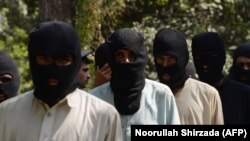The view southward from Central Asia has been grim since 2014, when groups of Taliban militants started fanning out across northern Afghanistan.
Thinly stretched government forces in the area were forced to enlist the help of local paramilitary groups, known as Arbaky, who arguably are often little more than bandits with a sheriff’s badge and might not be fighting Taliban forces at all. Some Arbaky are suspected of trafficking narcotics or even selling the weapons and ammunition that the government gives them to the Taliban.
And as the security situation in northern Afghanistan deteriorated, particularly in the northwestern part that not so many years ago was relatively peaceful, the black flag of the militant group Islamic State (IS) was raised in some isolated areas.
It was an added complication few wanted to see, including those north of the Afghan border.
Which is why the killing of Qari Hikmatullah, or simply Qari Hikmat, is probably welcome news for much of Central Asia and Russia.
Hikmat was killed in Faryab Province on April 5. He was the commander of an IS force in the Darzab district of Jowzjan Province, which borders Faryab to the east. Both provinces border Turkmenistan.
Hikmat had managed to hold off government and Taliban forces attacking him since summer 2017, and it was about the time Hikmat seized control of the Darzab district that there were reports that a handful of IS militants were caught in Turkmenistan. Ashgabat never confirmed that, but the Turkmen government in power at the time had virtually never confirmed any security threat to the country.
Russian officials have been warning Central Asian states about the threat from militants in Afghanistan for years. Hikmat’s announcement that he joined IS, and his ability to hold territory in Darzab, fueled the Kremlin’s dire predictions of instability spilling over into the “CIS southern border.”
Russian officials claim there are thousands of IS militants roaming northern Afghanistan, but the only place where there was absolutely someone occupying ground and declaring himself to be IS was Darzab under Hikmat.
Hikmat’s group was quick to announce a new leader -- Qari Habibul Rahman -- but he will be hard-pressed to replace the formidable Hikmat.
Hikmat was an extraordinary opportunist. He was part of the Taliban, but he apparently grew tired of following the commands of the Taliban leadership so he took his fighters over to the government, pledging to fight against the Taliban.
That did not last long, and he reportedly struck out on his own. He reinforced his own force with pro-IS militants who were already in northwestern Afghanistan, remnants of a Taliban-splinter group that had declared loyalty to IS and also a splinter group from the Islamic Movement of Uzbekistan (IMU) militant group that were present in Afghanistan and Pakistan’s tribal areas, and had also sided with IS.
The two groups joined to fight Taliban forces in northwestern Afghanistan at the end of 2015, but the Taliban pummeled them and the fighters scattered throughout northwestern Afghanistan.
Hikmat, himself an ethnic Uzbek from Afghanistan, was able to gather some of the former IMU fighters and others. There were reports that some IS fighters from Syria and Iraq had fled the battlefields there and joined Hikmat’s group.
The commander of U.S. forces in Afghanistan, General John Nicholson, said Afghan and U.S. forces had killed Hikmat “and they will kill any successors.”
So IS in northwestern Afghanistan seems to have suffered a major setback, and with both the government and Taliban forces intent on attacking them, the IS group’s days might be numbered.
It might be a rare bit of welcome news out of Afghanistan for the governments of Central Asia, and presumably Moscow, though it is unlikely the latter will tone down its alarming statements about the IS threat in Afghanistan.
Hikmat’s armed group is still in Jowzjan Province.
And of course, the Taliban is still there, too.







